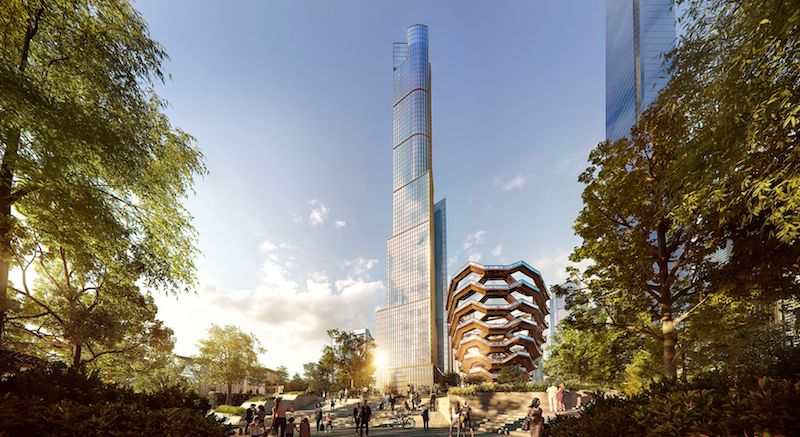Nonresidential construction spending in New York City is projected to reach $39 billion in 2018, a nearly 66% increase over the previous year. However, spending is also expected to tail off significantly during the following two years, according to a new report, Construction Outlook 2018-2020, released today by the New York Building Congress.
Spending for all types construction in New York City is in its fifth year of growth and could hit a record $61.8 billion this year, 25% more than in 2017. That growth is attributable in part to several large-scale projects. The New York Building Congress forecasts that, despite some anticipated falloff over the next two years, total construction spending through 2020 will total $177 billion.
Nonresidential construction alone—which includes offices, institutional, government buildings, sports and entertainment, and hotels—is forecast to add a record 39 million gross sf this year, followed by 30.4 million sf and 23.4 million sf in 2019 and 2020, respectively. The projected decrease in construction spending for nonresidential buildings over the next two years can be pegged to the completion of several big projects by 2020, such as the 58-story 1,401-ft-tall One Vanderbilt, and three buildings within the $20 billion Hudson Yards redevelopment.
(All this new floor space is coming at a time when New York’s office vacancy rate hovers around 13%, according to the website Optimal Spaces.)
Residential construction spending—which in New York is primarily for multifamily buildings—will total $14 billion in 2018, up 6% from the previous year. Next year, residential construction spending is expected to hit $15 billion, and then recede to $10.6 billion in 2020. (The totals include renovations and alterations.)
Over the three years, 60,000 housing units and 107.2 million gross sf will be added, states the report. The average annual unit count, though, would be off from the 27,898 housing units added to the city in 2017.
The report states that construction employment will show growth for the seventh consecutive year in 2018, and top 150,000 jobs for the second consecutive year. While the Building Congress predicts an employment dip—to 145,600 in 2019 and to 147,700 in 2020—those numbers would still be higher than the average for the last five years.
Related Stories
Hotel Facilities | Jan 22, 2024
U.S. hotel construction is booming, with a record-high 5,964 projects in the pipeline
The hotel construction pipeline hit record project counts at Q4, with the addition of 260 projects and 21,287 rooms over last quarter, according to Lodging Econometrics.
Multifamily Housing | Jan 15, 2024
Multifamily rent growth rate unchanged at 0.3%
The National Multifamily Report by Yardi Matrix highlights the highs and lows of the multifamily market in 2023. Despite strong demand, rent growth remained unchanged at 0.3 percent.
Self-Storage Facilities | Jan 5, 2024
The state of self-storage in early 2024
As the housing market cools down, storage facilities suffer from lower occupancy and falling rates, according to the December 2023 Yardi Matrix National Self Storage Report.
Designers | Dec 25, 2023
Redefining the workplace is a central theme in Gensler’s latest Design Report
The firm identifies eight mega trends that mostly stress human connections.
Contractors | Dec 12, 2023
The average U.S. contractor has 8.5 months worth of construction work in the pipeline, as of November 2023
Associated Builders and Contractors reported today that its Construction Backlog Indicator inched up to 8.5 months in November from 8.4 months in October, according to an ABC member survey conducted Nov. 20 to Dec. 4. The reading is down 0.7 months from November 2022.
Market Data | Nov 27, 2023
Number of employees returning to the office varies significantly by city
While the return-to-the-office trend is felt across the country, the percentage of employees moving back to their offices varies significantly according to geography, according to Eptura’s Q3 Workplace Index.
Market Data | Nov 14, 2023
The average U.S. contractor has 8.4 months worth of construction work in the pipeline, as of September 2023
Associated Builders and Contractors reported that its Construction Backlog Indicator declined to 8.4 months in October from 9.0 months in September, according to an ABC member survey conducted from Oct. 19 to Nov. 2. The reading is down 0.4 months from October 2022. Backlog now stands at its lowest level since the first quarter of 2022.
Multifamily Housing | Nov 9, 2023
Multifamily project completions forecast to slow starting 2026
Yardi Matrix has released its Q4 2023 Multifamily Supply Forecast, emphasizing a short-term spike and plateau of new construction.
Contractors | Nov 1, 2023
Nonresidential construction spending increases for the 16th straight month, in September 2023
National nonresidential construction spending increased 0.3% in September, according to an Associated Builders and Contractors analysis of data published today by the U.S. Census Bureau. On a seasonally adjusted annualized basis, nonresidential spending totaled $1.1 trillion.
Market Data | Oct 23, 2023
New data finds that the majority of renters are cost-burdened
The most recent data derived from the 2022 Census American Community Survey reveals that the proportion of American renters facing housing cost burdens has reached its highest point since 2012, undoing the progress made in the ten years leading up to the pandemic.

















